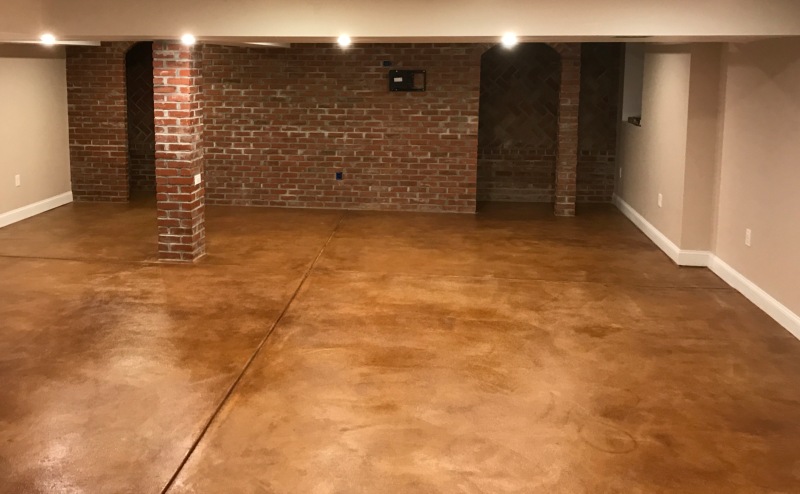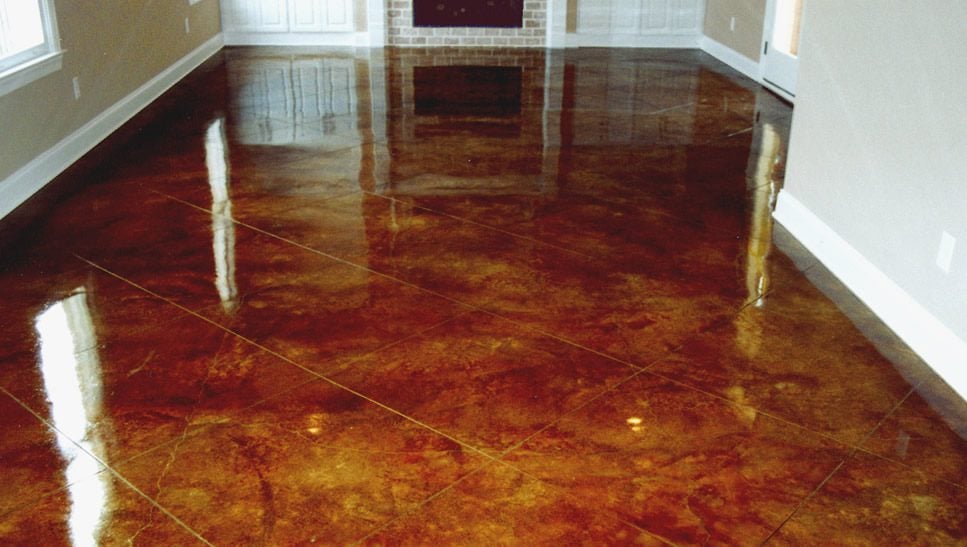How to evaluate a stained concrete company
Wiki Article
Comprehending the Various Kinds Of Stained Concrete for Your Following Job
Stained concrete deals different alternatives that provide to different visual and functional needs. Each kind offers distinct qualities that affect the last appearance and longevity of the surface. Comprehending these distinctions is essential for anybody preparing a job. From rich, chain reactions of acid-based stains to the dynamic uniformity of strong color stains, the selections can substantially affect the end result. What variables should one consider when selecting the excellent tarnish for their particular demands?Overview of Stained Concrete
Stained concrete functions as a versatile flooring choice that can boost the aesthetic appeal of numerous spaces. This method includes using a coloring representative to the surface area of existing concrete, permitting a broad range of style opportunities. Stained concrete is popular in both residential and commercial settings, providing a resilient and low-maintenance remedy that can imitate the look of all-natural materials like stone or ceramic tile.The staining procedure can be carried out making use of water-based or solvent-based products, each supplying distinct visual results. The final look is affected by elements such as the initial concrete surface, the sort of tarnish used, and the application method. Stained concrete not only improves interiors and outsides but likewise advertises sustainability by renewing existing concrete frameworks. As a result, it has obtained traction among house owners and developers looking for both functionality and style in their flooring options.
Acid-Based Stains: Characteristics and Benefits

Unique Color Variants
Concrete surfaces can transform drastically with the application of acid-based stains, which supply a rich combination of one-of-a-kind shade variants. These stains permeate the concrete, responding chemically to generate vivid earth tones that range from deep browns and reds to soft environment-friendlies and blues. The resulting hues are commonly variegated, creating a natural, marble-like appearance that improves the concrete's character. Each application returns distinctive results because of variants in the concrete's structure and the staining method utilized, making every task one-of-a-kind. Additionally, acid-based stains can be split or combined with other techniques to produce personalized styles, enabling for individual expression. This versatility makes acid-based stains a popular option for both household and industrial applications.Chain Reaction Discussed
While lots of variables add to the performance of acid-based stains, the underlying chemical responses play an important role in their special features and advantages. These stains mainly contain water, acid, and metal salts. When used to concrete, the acid responds with the calcium hydroxide in the cement, producing a chemical makeover that leads to long-term shade changes. The metal salts penetrate the surface area and bond with the concrete, enabling a variety of tones and tones. This reaction not just improves visual charm yet also supplies durability, making the shade immune to fading and wear. Furthermore, acid-based stains can develop a variegated surface that imitates all-natural rock, further boosting their appeal for ornamental concrete applications.Surface Prep Work Relevance
Accomplishing perfect outcomes with acid-based stains depends upon extensive surface preparation. This essential step guarantees that the concrete surface area is tidy, devoid of contaminants, and effectively profiled for suitable stain absorption. Any existing sealants, dirt, or oils can impede the chain reaction that creates the wanted color and coating, causing unequal or patchy outcomes.Before applying the stain, the concrete needs to be mechanically cleaned or stress washed, complied with by a thorough assessment for cracks or flaws that might require fixing. Furthermore, verifying the surface is appropriately dried will improve tarnish adherence. By prioritizing these preparatory steps, the long life and vibrancy of acid-based stains can be significantly boosted, causing an extra cosmetically pleasing and resilient surface.
Water-Based Stains: Attributes and Advantages

Water-based stains permeate the concrete, supplying a more clear surface that highlights the all-natural texture and variations of the surface area under. They are available in a broad variety of shades, enabling for imaginative flexibility in design. In addition, water-based stains are much easier to cleanse up, needing only water and soap, which simplifies the application process.
Their fast drying out time enhances efficiency, making them a sensible selection for both DIY fanatics and professionals. On the whole, water-based stains provide an appealing combination of visual versatility and straightforward buildings, making them a prominent alternative for concrete improvement tasks.
Solid Color Stains: Dynamic Choices for a Strong Appearance
Strong shade stains use an effective solution for those seeking to create a bold and dynamic aesthetic on concrete surfaces. These stains give a consistent pigmentation that can significantly enhance the visual appeal of floors, patios, and driveways. Available in a broad range of shades, solid color stains enable creative expression, dealing with numerous layout choices.One of the vital advantages of solid shade stains is their capability to hide imperfections, giving a fresh and sleek aim to maturing concrete - stained concrete company. Furthermore, their formula typically consists of UV-resistant buildings, ensuring long life and color retention also in extreme weather problems
Application is Look At This straightforward, requiring very little preparation of the concrete surface area. When used, strong color stains can be secured for included security and luster, additional boosting their aesthetic top quality. With their dynamic alternatives, solid shade stains are an outstanding selection for those aiming for an impactful and natural layout.
Semi-Transparent Stains: Accomplishing Deepness and Measurement
Semi-transparent stains supply a distinct technique to enhancing concrete surfaces by providing deepness and measurement with numerous color alternatives. Recognizing the application techniques is important for attaining the preferred result, while proper upkeep practices ensure long life. This area will check out these key elements to optimize the benefits of semi-transparent staining.Shade Options Available
A large selection of color alternatives exists for semi-transparent stains, enabling homeowners and designers to improve the all-natural charm of concrete surface areas. These stains are available in a range of tones, from earthy tones like browns and terracottas to vivid colors such as blues and environment-friendlies. The semi-transparent nature of these stains allows the underlying concrete to reveal through, producing an unique deepness and measurement that can match various design visual appeals. Furthermore, incorporating various colors can create custom-made tones, enabling a tailored search for each task. This flexibility makes semi-transparent stains a preferred choice for both interior and outside applications, as they can harmonize with surrounding elements while including aesthetic interest to ordinary concrete.Application Strategies Clarified
To attain the preferred depth and dimension with semi-transparent stains, appropriate application methods are essential. Surface area preparation is critical; the concrete needs to be tidy and totally free of any pollutants. This usually entails power washing and repairing any splits. Next, picking the appropriate applicator, such as a sprayer, roller, or brush, can affect the last look. Sprayers permit a much more also application, while rollers can help accomplish appearance. It is essential to apply the tarnish in thin, also coats, allowing each layer to dry prior to adding another. Adjusting the application strategy, such as differing pressure or using various tools, can develop special results. Finally, securing the stained surface boosts the vibrancy of the colors while giving security.Upkeep Best Practices
Normal maintenance is vital for preserving the charm and honesty of surfaces treated with semi-transparent stains. To keep these surfaces, routine cleansing is vital. Making use of a pH-neutral cleaner and a soft-bristle broom will certainly assist remove dust and particles without damaging the discolor. It is recommended to prevent rough chemicals, address as they can deteriorate the discolor's look. Additionally, regular resealing every one to three years can secure versus wear and fading. This process entails cleaning the surface extensively and using a suitable sealer made for stained concrete. House owners need to also keep track of for any type of indications of staining or damage and address these concerns immediately to guarantee resilient vibrancy and durability. Following these finest methods will certainly improve the general life expectancy of semi-transparent stained surface areas.Impacts and Techniques: Customizing Your Stained Concrete
Personalizing stained concrete includes a range of techniques that enhance both appearances and functionality. Amongst these approaches, layering various discolor shades can produce deepness and complexity, permitting unique aesthetic results. Methods such as acid staining give a variegated look, while water-based stains provide a much more uniform appearance.Furthermore, integrating attractive patterns, such as stenciling or engraving, can additionally customize the surface area, including elaborate designs that provide to private tastes. Texturing the concrete, whether via stamping or mop surfaces, introduces responsive elements that not only improve grasp however likewise enhance visual interest.
Furthermore, using sealers can amplify the shade vibrancy and offer protection against wear. Modification methods extend past mere shade; they can change a typical concrete piece right into a sensational centerpiece, making it appropriate for both residential and industrial spaces. With careful option of effects and strategies, stained concrete can achieve an absolutely tailored look.
Maintenance and Durability of Stained Surfaces
Although stained concrete surfaces are recognized for their toughness and visual charm, keeping their integrity is necessary for guaranteeing long life. Regular cleaning is essential; sweeping and wiping with a pH-neutral cleaner assists protect against dust build-up and discoloration. Additionally, applying a see here now sealant every couple of years can protect the surface from moisture, chemicals, and UV damage, consequently boosting its lifespan.It is also crucial to attend to any kind of splits or chips immediately. Tiny repairs can minimize more wear and tear, protecting the visual and structural high quality of the surface. For exterior stained concrete, seasonal upkeep, such as removing snow and ice, is required to stop surface damages from freeze-thaw cycles.
Regularly Asked Inquiries
Can I Discolor Existing Concrete Surfaces or New Ones?
The question of whether existing concrete surface areas can be stained emerges often. It is indeed feasible to discolor both brand-new and old concrete, supplied the surface is appropriately ready and without contaminants for optimal adhesion.The length of time Does the Staining Process Generally Take?
The staining process normally takes one to three days, relying on elements such as surface prep work, kind of tarnish, and weather. stained concrete contractors. Treating time might prolong past initial application, affecting the overall period substantiallyIs Stained Concrete Safe for Outdoor Use?
Stained concrete is usually risk-free for exterior use, gave it is correctly secured. This sealing safeguards versus wetness and UV damage, ensuring toughness and safety, while additionally improving the visual allure of outdoor areas.Can I Apply Several Stain Layers for Different Impacts?
Using multiple stain layers can accomplish different results on stained concrete. It is essential to guarantee compatibility in between stains and enable appropriate drying out time in between applications to stay clear of unintended reactions or discoloration.Are There Any Type Of Color Limitations for Stained Concrete?
Color constraints for stained concrete largely depend on the kind of stain used, with water-based stains providing a wider combination contrasted to acid-based stains. stained concrete floors. Achieving vibrant shades might call for cautious option and application strategies.Report this wiki page